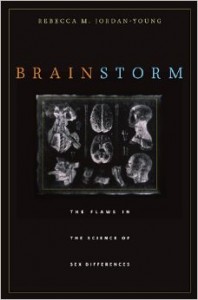 Brain Storm: The Flaws in the Science of Sex Differences
Brain Storm: The Flaws in the Science of Sex Differences
by RebeccaM. Jordan-Young
Harvard Univ. Press. 394 pages, $35.
 Gay, Straight, and the Reason Why: The Science of Sexual Orientation
Gay, Straight, and the Reason Why: The Science of Sexual Orientation
by Simon LeVay
Oxford Univ. Press. 412 pages, $27.95.
CRYSTAL WAS WORRIED that she had male orgasms. So she came in to the Disorders of Sex Development (DSD) Clinic three years ago for a consultation with a phalanx of specialists: a urologist, a geneticist, an endocrinologist, and me, the psychiatric consultant. We mainly see infants and young children, so she was unusual just for being eighteen. Her history was not so unusual. Crystal had been born with a large clitoris (clitoromegaly) and partially masculinized external genitalia. This prompted a medical work up resulting in a diagnosis of Congenital Adrenal Hyperplasia (CAH).
CAH refers to a group of inherited genetic disorders caused by a mutation in one of five genes that code for enzymes involved in the synthesis of steroid hormones in the adrenal gland. Due to the decrease or non-function of this enzyme, there can be diminished synthesis of some hormones (such as cortisol) and overproduction of other hormones (such as androgens) in the complex cascade of steroid hormone synthesis. Over ninety percent of CAH cases are due to a defect in the 21-hydroxylase enzyme, which results in the overproduction of androgens in early fetal development and thus the masculinization of the genitalia in a genetically female fetus or 46,XX. In the most severe form of 21-hydroxylase deficiency (so-called “salt-wasting CAH”), both 46,XX and 46,XY infants will lose excess sodium in their urine, become dehydrated, and die if not treated chronically with hydrocortisone. Depending on the amount of androgen overproduction and its timing in utero, the external genitalia of 46,XX fetuses masculinize to different degrees. This can range from minor clitoromegaly and reduction in the vaginal opening to the scrotalization of the external labia and the formation of a urethra in a phallic-like clitoris. In extreme cases, a 46,XX infant with CAH can be born with totally male-appearing external genitalia, but no testes or other male internal organs.






